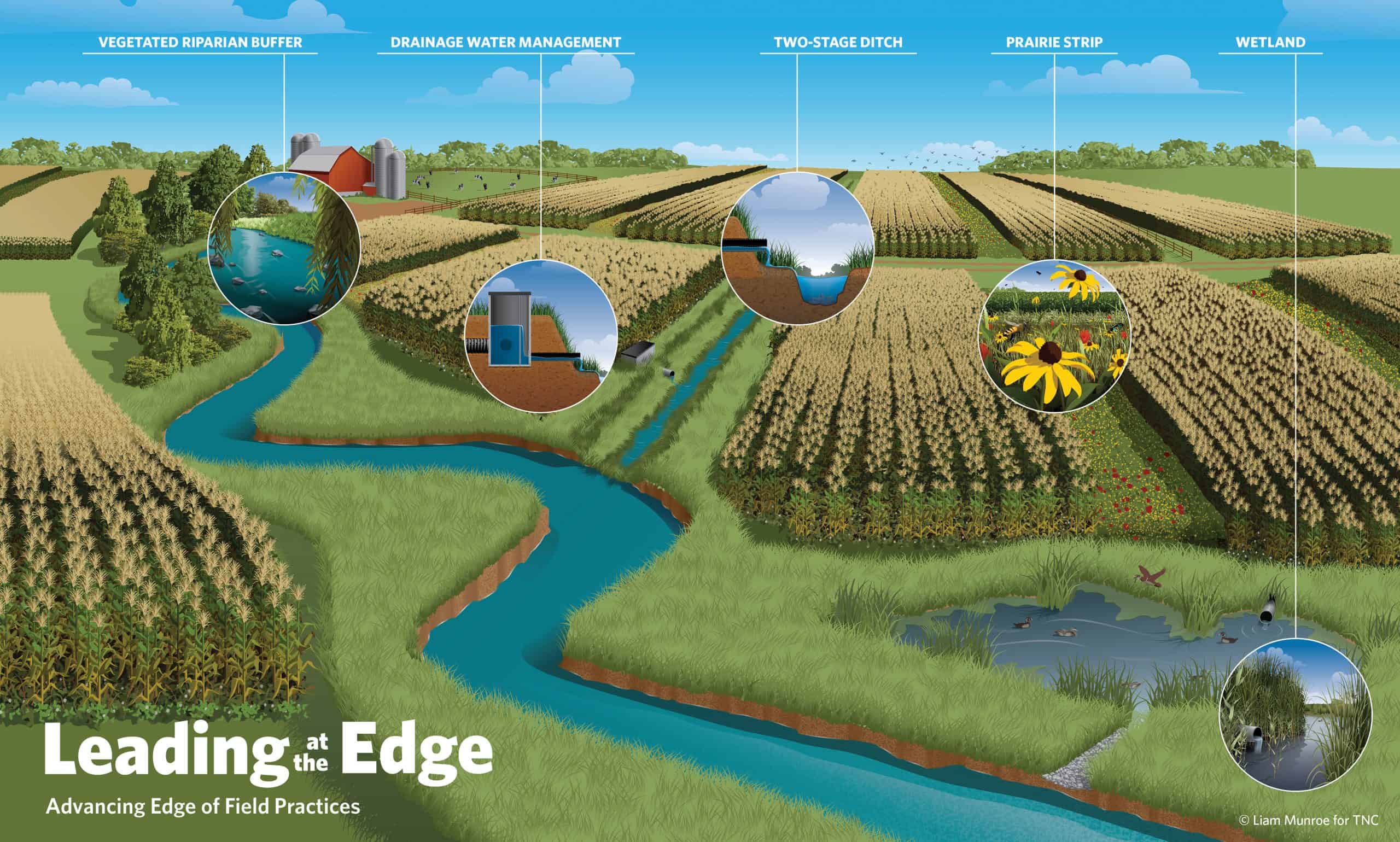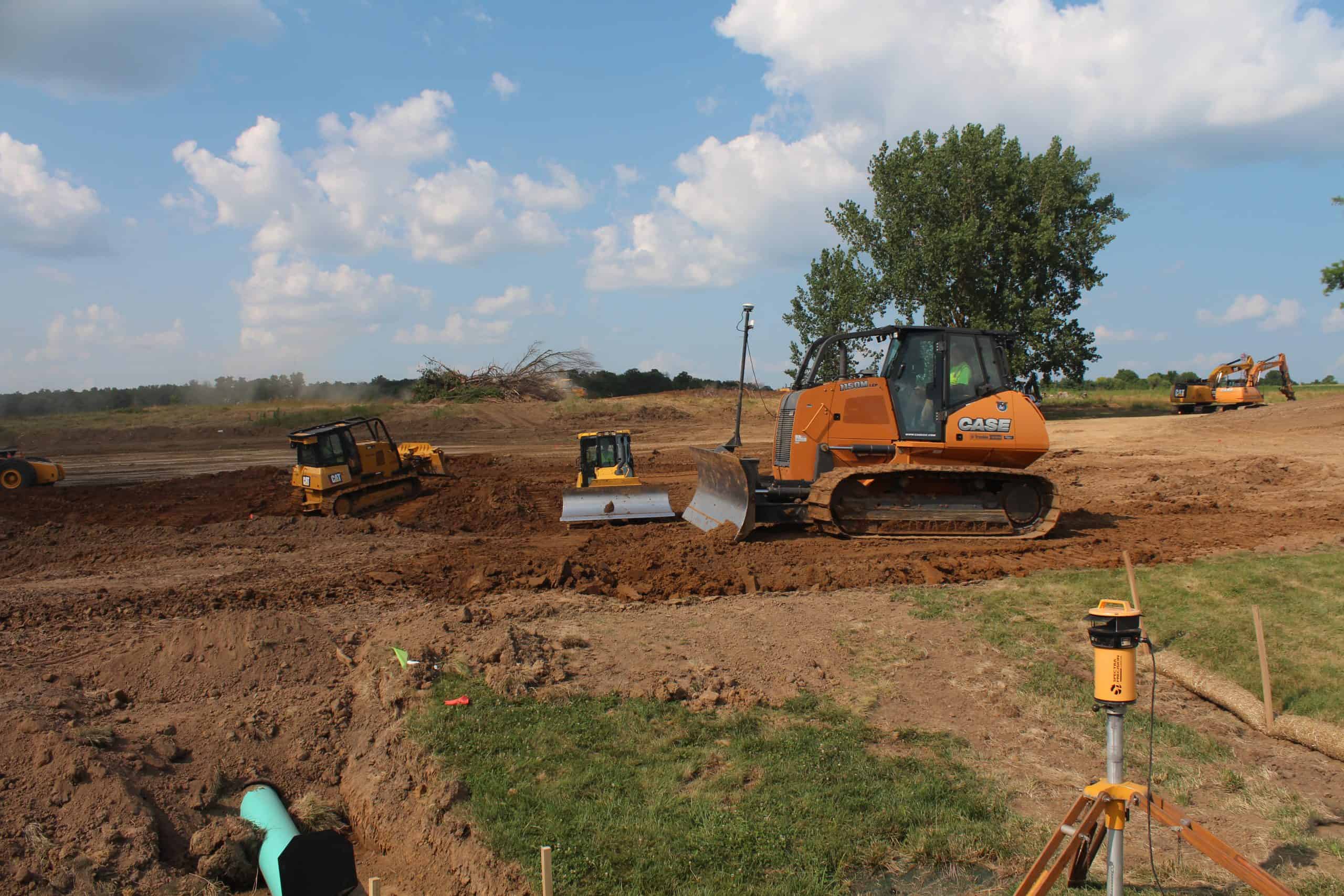Roadmap seeks to accelerate adoption of edge of field conservation practices
In early 2021, The Nature Conservancy, the Soil and Water Conservation Society, and Meridian Institute released Leading at the Edge: A Roadmap to Advance Edge of Field Practices in Agriculture, a new resource to build awareness, generate momentum, and catalyze adoption of conservation practices such as wetlands, buffers, and filter strips that provide nutrient retention and removal, along with valuable biodiversity and ecosystem service benefits.
The EoF Roadmap, which was collaboratively developed with engagement from 26 agricultural and environmental leaders from across the U.S., advances a set of nine action-oriented recommendations and calls for conservation groups, policy makers, farmers, farm organizations, supply chain companies and other agricultural stakeholders to work collaboratively for a robust and sustainable food system. The recommendations are organized around three key pillars – developing the economic case, building capacity to implement, and promoting a culture of conservation and innovation – with special emphasis on the underlying investments in science, technology and data, alignment of policies and programs, and clear communication about the value of EoF practices that are critical for success. (See www.nature.org/EdgeOfField.)

The Edge of Field Roadmap lays out a pathway for accelerating the adoption and implementation of buffers, wetlands, and other practices that improve water quality and provide other valuable ecosystem services. Illustration by Liam Munroe for TNC.
EoF practices have value in Illinois
The IL Nutrient Loss Reduction Strategy (NLRS) calls for a 45% reduction of nitrogen and phosphorus losses from urban and agricultural sources by 2035. Meeting these ambitious goals requires widespread adoption of both infield soil health and nutrient management practices and EoF filtration and treatment practices. Conservation drainage practices – constructed wetlands, saturated buffers, bioreactors, and controlled drainage – are especially important for reducing nitrate losses from tile-drained fields common in IL and surrounding states.
EoF practices bring tremendous value to Illinois’ agricultural landscape. Research and monitoring data show that many EoF conservation practices provide significant water quality improvements, particularly by reducing nitrogen, phosphorus, and sediment losses from surface and subsurface drainage. In addition to their water quality benefits, EoF practices can provide critical ecosystem service benefits, such as pollinator and wildlife habitats, flood storage, and streambank stabilization, that increase resiliency and reduce risk for growers.
The long-term nature of EoF practices means that their benefits accrue over many years, making them a cost-effective conservation infrastructure investment. Further, some EoF practices can be sited in areas not well-suited for crop production or that have already been set aside. For example, saturated buffers and bioreactors can be placed within existing filter strips, improving their nutrient removal function, without taking up additional acres, while constructed wetlands are well-suited for marginal acres or difficult to farm areas.
ISAP’s work to accelerate EoF adoption and implementation

Field installations of conservation drainage practices like constructed wetlands and saturated buffers are a valuable outreach, education, and training tool. Here a constructed wetland is installed during a 2019 ISAP field day at Illinois Central College, with leadership from The Wetlands Initiative and the IL Land Improvement Contractors Association. Photo by Jill Kostel.
The IL Sustainable Ag Partnership (ISAP) is committed to advancing EoF practices as part of its whole-systems approach to improving soil health and reducing nutrient loss, and ISAP’s member organizations are leading several efforts to overcome the technical, administrative, programmatic, and financial barriers commonly associated with widespread EoF practice adoption. Regular workshops, demonstrations, and outreach materials are designed to help normalize EoF practices, simplify the planning and implementation processes, and support producers, landowners, contractors, drainage commissioners, conservation professionals, and others as they gain more first-hand experiences with them.
Capacity and Training: ISAP’s Advanced Conservation Drainage Training (ACDT) Program was developed to build the capacity needed to implement conservation drainage practices among soil and water conservation professionals, drainage engineers, land improvement contractors, and others. Approximately 40 individuals from throughout IL completed the three-part training sessions in 2018 and 2019, and a more general, virtual workshop series was offered in 2020. Several of these training participants are available to share their knowledge and expertise as conservation drainage specialists, and many are actively working with clients and local partners to plan and implement new projects. ISAP anticipates hosting additional training sessions to continue building technical capacity on conservation drainage topics.
Practice Demonstration: Concurrent with the ACDT program, ISAP hosted field days to demonstrate saturated buffer and constructed wetland installations. Key partners, including The Nature Conservancy, (TNC,) The Wetlands Initiative (TWI), and the IL Land Improvement Contractors Association (IL LICA), supported these hands-on events that provided conservation partners and local landowners with opportunities to increase their familiarity with the functions and installation processes of key conservation drainage practices.
Monitoring and research: TWI and TNC each have partnered with private landowners throughout central Illinois to install constructed wetlands through the Conservation Reserve Program (CRP) and the Environmental Quality Incentives Program (EQIP). Monitoring data from several of these constructed wetlands suggests that they are extremely effective at reducing both nitrate and dissolved phosphorus from tile drainage under a range of conditions. Long-term data on practice effectiveness, along with landowner perspectives on program participation, barriers, and outcomes are valuable in outreach efforts to new landowner partners, and to demonstrate the value and impact of federal and state cost-share programs. (More: NLRS podcast features constructed wetlands)
Several related ISAP efforts are also contributing more broadly EoF practice expansion:
- ISAP member organizations are advocating for the Illinois Legislature to consider and pass the Partners for Nutrient Loss Reduction Act. This funding would support current and increased capacity within soil and water conservation districts, which are key for delivering conservation programs and technical assistance to farmers and landowners.
- Through ISAP’s advanced soil health training program, there are opportunities to consider connections among improved soil health, drainage, and targeted EoF opportunities.
- Efforts to advance conversations about ecosystem service markets may provide new financial opportunities for conservation adoption, including for EoF practices.
Meeting IL’s water quality goals while supporting the agricultural industry that drives our economy requires a collaborative, all-hands-on-deck approach, including policy and program level changes, improved financing mechanisms, and efforts to remove technical and administrative adoption barriers. The EoF Roadmap lays out a pathway for achieving EoF practice adoption at scale, and ISAP is a critical partner in driving this work forward. Its members will continue their efforts to accelerate EoF adoption and to create new opportunities that enable our agricultural communities and industry partners to achieve the water quality, habitat, and ecosystem service benefits possible through widespread adoption of sustainable agricultural practices – in farm fields and at their edges.
View the EoF Roadmap and associated resources at www.nature.org/EdgeOfField.